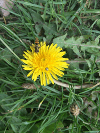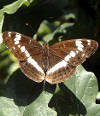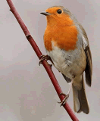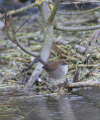Carter's Copse

1) Following the main path from Alver Valley East Car Park will bring you to an open area of grassland (on your right), named Hither Meadow. This area is managed using a method known as Cut and Collect. This method prompts a greater diversity of native flora (and therefore fauna) such as Ragwort, Dandelion, Clover, Yarrow and Nettle. These plants offer good habitat for a number of invertebrate and vertebrate species.

Marmalade Hoverfly on Red Clover

Marmalade Hoverfly and 16 Spot Ladybird on Dandelion
2) Here you will see Gosport's oldest fortification - a Motte and Bailey. This is a Scheduled Ancient Monument. It was built soon after the Norman Conquest in 1066 to defend a crossing point on the River Alver. The Motte or mound would have had a wooden or stone fortified tower on top. The Bailey is an enclosed space where people can live and work. Buildings could include: barracks, kitchens, stables, workshops and habitation buildings. A Motte and Bailey would normally share a combined defence of a deep ditch and wooden fencing made of stakes called a Palisade.
At the bottom of the Motte is a World War 2 Pill Box, this was erected to protect Grange Airfield. This Airfield would have taken up a large part of Rowner during World War 1 and later given to the Royal Navy during World War 2. Pill Boxes can be found throughout Gosport.

3) Leaving the Pill Box behind you and following the main path will bring you to an open glade area which offers excellent habitat for a number of invertebrates,such as the rare White Admiral, Speckled Wood, Brimstone and a number of other butterfly species. These can be seen feeding in sunny areas around the glade. Varieties of wasps and bees are also present; moths and other insects are present later in the day and make an invaluable food source for bats.

Speckled Wood Butterfly

White Admiral Butterfly
4) Carter's Copse Nature Trail takes you to Hangmans' Hollow. The story goes that Rabbit Skin Jack, a poacher, hung himself from an oak tree. His ghost is supposed to haunt the woods.

Sunset in Carter's Copse
5) The wooded area offers shelter, nesting and food for birds such as Great Tits, Blue Tits, Wrens and Robins with Goldcrests in winter.

Blue Tit

Robin
6) Along this path are several large oaks approximately 200 years old. Oak trees support 284 insect species and an abundance of other wildlife like squirrels, tawny owls and woodpeckers. Brambles provide food, habitat and protection for small animals.
7) The Boardwalk dissects a pond. Ponds are important for a number of aquatic plants and invertebrates and offer unique habitat. These in turn provide food for bats, birds and other mammals.
Ponds provide invaluable spawning grounds for a number of dragonflies such as the Southern Hawker.

Female Southern Hawker egg laying near the Black Lagoon
8) This path takes you through an area of gorse which supports a large number of insects and therefore birds. Along the path edge there are a number of wild flowers including White Campion, Greater Stitchwort and Wood Sage. The path rejoins the main track near the pond.
9) From this point you have a good view over a small section of the reed-bed. Alver Valley has one of the largest reedbeds on the South Coast. This is invaluable habitat for many species including Water Voles which are nationally threatened. Water Voles were reintroduced into Alver Valley during 2010 following the control of Mink which is a detrimental invasive species. Reedbeds help battle climate change by locking up carbon in their root base, making it highly beneficial. Cettis Warbler along with Sedge and Reed Warbler can often be heard here.

Water Vole

Cettis Warbler
10) Back on the main route, the inner path takes you through the Alder Carr, a marshy area of woodland. This area is home to specialist wetland plants in-cluding Yellow Iris and Marsh Marigold.

Alder catkins
Remember!
Carter's Copse is an important area of nature conversation. We hope you enjoy it's unique attractions.
Please observe the following:-
- Take all litter home.
- Do not pick or uproot flowers or plants.
- Do not start fires.
- Do not remove dead wood. This is an
important part of the ecosystem -
200 insect species live in and on dead wood. - Keep your dog under control.




